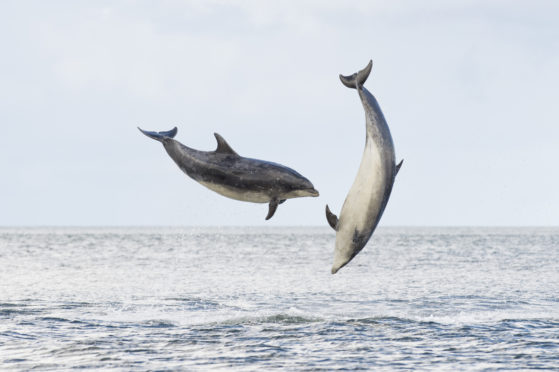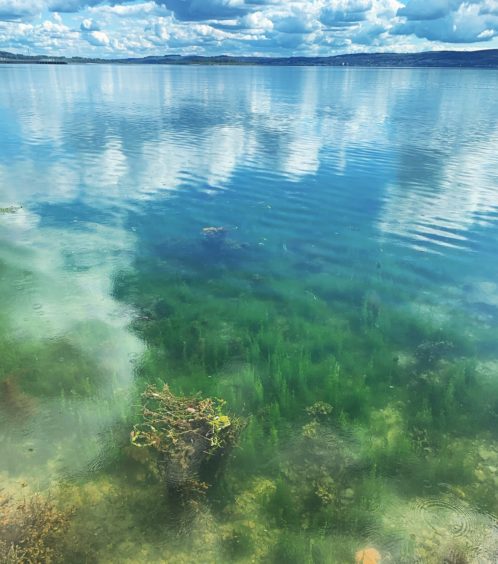
The rest of us might be more stressed than ever but whales and dolphins around Scotland’s coasts have never been happier thanks to the newly silent seas.
Noise levels caused by humans on the oceans have plummeted as Covid-19 restrictions have limited military exercises, commercial shipping and pile driving on the sea bed.
Now whales and dolphins are reclaiming their territory, with reported sightings in places where they rarely venture.
Spotters who live within walking distance of coasts and rivers are reporting sightings to Whale and Dolphin Conservation as part of its Shorewatch programme.
A pod of Orcas was spotted feeding around the Shetland Islands instead of moving into waters closer to Thurso.
Six bottlenose dolphins from the Moray Firth were also filmed swimming in Hopeman Harbour, Elgin, last week – the largest pod seen in the area. And there have been numerous dolphin sightings near Torry Battery in Aberdeen, and also between Losssiemouth and the Tarbat Ness lighthouse, while minky whales have been seen in the Moray Firth.
Danny Groves of Whale and Dolphin Conservation said: “It must be a good time to be a wild whale or dolphin, swimming around the ocean or up river. While we are locked down, they will be reclaiming their territory. One reason might be that their homes must seem so much quieter – and cleaner. Man-made noise levels will have reduced in the lockdown and that can only be a good thing for these amazing creatures.
“Noise from military exercises, commercial ships, and pile driving the sea bed all cause big problems for whales and dolphins because they live in a world of sound.
“Pumping high levels of underwater noise into their world has huge effects, and can cause them stress, pain and even death.
“These primarily acoustic creatures now are able to hunt, navigate and socialise much more effectively in an environment experiencing a reduction in human activity.
“In the future we will likely begin to understand how significant, and potentially profound, the enforced changes caused by lockdown.”
Studies have shown that whales and dolphins suffer stress, pain and can even die because of the impact of noise. Research in America showed a six decibel drop in noise levels when non-essential shipping was suspended by a security lockdown after the 9/11 terror attacks in 2001. Levels of stress hormones recorded in whales dropped during the same period.
The breeding rate could also improve while the ocean environment is quieter as the singing of male whales to attract mates will be audible over a longer distance.
The threat of “ship-strike” will also have dropped with the reduction of shipping traffic as whales are often killed at sea after colliding with large vessels.
Steve Truluck, a volunteer of eight years for WDC’s Shorewatch, who filmed the six dolphins swimming into Hopeman Harbour, said: “The dolphins in the harbour was 100% something different.
“I haven’t met a single person who has told me they have seen dolphins do that and I’ve been watching them for eight years. They rely on sound for communication and to find food. If you suddenly remove all the noise we make then it’s a much more dolphin-friendly environment for them.
“I’ve barely seen any trawlers at all and there’s no pleasure fishing going on. The whales and dolphins are blissfully unaware of what we’re going through.”
Pollution from shipping and industry is also a threat to whales and dolphins. In 2016, a female orca known as Lulu was found dead off the west coast of Scotland with the highest-ever recorded levels of toxic pollutants found in a marine mammal.
The Scottish Environmental Protection Agency say it’s too soon to say if the lockdown will have an impact on water pollution but anecdotal evidence has shown encouraging signs.
One resident in the seaside town of Helensburgh shared a picture on social media this week, showing the usually steely-grey Firth Of Clyde had taken on an almost tropical hue.
Gavin Slater, who took the photo, said: “I’ve never seen the waters so clear. We are across from Greenock which is usually a cruise ship stop-off and we have Faslane naval base just up the road, so I don’t know if maybe there’s less traffic right now which has led to less sediment being churned up. With the sun shining, it looked more like the Caribbean than the west coast of Scotland.”
Marine Conservation Scotland said: “What we hope is that people are enjoying reconnecting to nature at this time and seeing the value of having a thriving environment and we hope this will lead to big changes in how we live and work on this blue planet of ours when we start to come out of the current health crisis.”

Enjoy the convenience of having The Sunday Post delivered as a digital ePaper straight to your smartphone, tablet or computer.
Subscribe for only £5.49 a month and enjoy all the benefits of the printed paper as a digital replica.
Subscribe